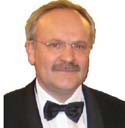Keynote Speaker-----Prof. Sigitas Tamulevičius

Member of the European Materials Research Society
Professor of the Physics Department, Kaunas University of Technology (KTU), Republic of Lithuania
Keynote Speech Title:Optical properties of noble nanoparticle based structures
Abstract:Nanoparticles of noble metals demonstrate interesting properties of local enhancement of electromagnetic field, catalytic activity and many other unique properties finding multiple applications. Properties of such nanoparticles depend on their size distribution, mutual position and surrounding material. Now days often the goal is to use the nanoparticles as building blocks and assemble them into prescribed and complex structures in order to harvest their unique properties and realize them in novel nanoelectronic, biosensors and photonic devices.
In the current research we analyse bottom-up and top-bottom and approaches in the production of diverse nanoparticle based systems.
In the bottom-up approach we present the experimental results of template based ordering of nanoparticles by the capillary forces using our custom deposition setup. Deposition is done by confining and moving droplet with suspension of particles over the template where capillary forces drive particles to assemble on predefined trapping sites. This assembly approach offers high placement precision, scalability and much higher throughput compared to methods, like geometry-induced electrostatic trapping or optical tweezers. Holographic lithography and electron beam lithography following by the replication techniques have been employed to produce large area nanostructured templates. We report experimental results of dynamics of particle accumulation zone formation at a contact line (liquid–solid–vapor interface) and consequently induced deposition efficiency at different velocity and thermal regimes. Two types of patterns with different trapping sites density were used in order to assess influence of the pattern density and geometry on the deposition yield.
In the top-down approach we use different modes (direct current - DC and high ionization pulsed magnetron sputtering - HIPIMS) of reactive magnetron sputtering to deposit metallic nanoparticles in the DLC matrix. Such kind of nanocomposites can be further structured using laser ablation either reactive ion etching employing lithographically produced masks.
Ultrafast relaxation processes in diamond like carbon (DLC) thin films with embedded Cu, Ag nanoparticles as well colloidal solutions of nanoparticles used in the capillary force assisted d deposition were investigated in detail employing a high sensitivity transient absorption spectrometer. Dependences of localized surface plasmon resonance (LSPR) relaxation dynamics on nanoparticle concentration/diameter as well as excitation wavelength and intensity, which was varied almost by two orders of magnitude, were studied. This approach enabled to study the excited LSPR electron-phonon relaxation also known as “hot” electron relaxation and to reveal a clear “hot” electron relaxation dynamics dependence on parameters of the nanoparticle systems.
